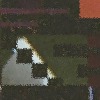As Gaja said, bit depth _solely_ defines the signal to noise ratio of a digital recording, nothing more. Each bit gives you 6dB of S/N ratio, giving you 96dB of S/N ratio for 16bit files and 144dB S/N ratio for 24bit files. 96dB alone is probably more than some of the analog components behind the D/A playing your music can do and given that most music doesn't have more than 24dB of effective dynamic range its well enough for a final output.
However, when you export stems to be imported for further processing or generally export for further processing you want to keep the maximum possible S/N ratio and export at 24bit.
As for sample rate, just keep the sample rate consistent during the whole process. If you recorded / composed at 44.1, keep it that way. As gaja also indicated the outcome of sound generation and processing is somewhat dependent on sample rate (in some cases) although the difference in a recording itself isn't really distinguishable between 44.1k and 192k (don't let Neil Young tell you otherwise

). Reducing (or upping) sample rate is a relatively complicated process and Reason does admittedly not have the best sample rate conversion on the market.
As soon as you're going to compressed formats like mp3 the concept of sample rate vanishes anyway as these types of compression store the data in the frequency domain and not in the time domain. "Inside" an mp3 there is no such thing as sample rate, only when its decompressed by the player this concept comes back in and the quality depends on the decoder (and encoder of course).



